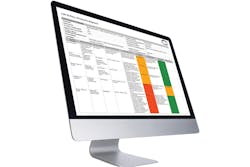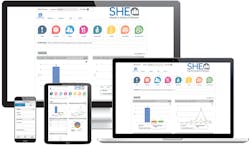When it comes to motivating and engaging a workforce in intellectually challenging, absorbing tasks, few employers will pretend that workplace inspections are a sure-fire hit.
Commonly seen as time-consuming, tenuous and tiresome, workplace inspections are one of those inevitable but necessary "pain points," which form a vital — but arduous — part of the management of safety in the workplace.
Inspections, when carried out properly, are crucial to the maintenance and continuous improvement of working environments, particularly in the process industries. As a key factor in the identification and recording of hazards, well-planned and managed inspections are crucial when it comes to avoiding accidents, preventing worker injuries and potentially even saving lives.
According to the Occupational Health and Safety Administration (OSHA), companies in the U.S. spend a staggering amount of money — more than $170 billion — on costs associated with injuries and illness in the workplace, on an annual basis.
From a financial standpoint alone, these figures show that organizations need to take workplace safety and accident avoidance seriously. Add in the prospect of a major event, or even a fatality, and the financial cost pales into insignificance beside the enormity of the potential damage to an organization’s reputation and morale.
Environment, health and safety (EHS) is often seen as a "box-ticking exercise," and assumes a low place on most lists of priorities as a result — and, as every manager knows, when a task is allowed to slide down a list of priorities, there will eventually come a time when it will be ignored entirely.
A successful EHS policy, however, with a concentrated focus on a well-planned workplace inspection schedule, is essential not only in maintaining a safe workplace, but also in ensuring compliance with the law. The key to changing employees’ attitude toward safety lies in developing a "culture of safety," where safe working practices become embedded in every employee’s day-to-day role.
A major barrier to the development of such a safety culture — at all levels, from managerial to the factory floor — is a lack of worker engagement. Indeed, it is the most pressing safety concern for EHS professionals, as evidenced in EHS Daily Advisor’s 2017 Annual Safety Report. The report quizzed almost 700 organizations, of which more than half reported employee engagement was their most common safety challenge.
Ironically, workplace inspections are a proven method of increasing worker engagement, enabling safety professionals to listen to workers’ concerns, to gain further understanding of jobs and tasks and to recommend well-informed and relevant corrective action, rather than imposing an "expert view" that might miss the mark.
Job safety analysis report. Graphic courtesy of SHE Software
In the modern commercial environment where continuous improvement is crucial to success, regular inspections and audits can help organizations move from reactive to proactive safety management.
Furthermore, inspections are an employer’s chance to listen to employees and empower them to ask questions, raise concerns, highlight key issues and make all-important suggestions as to how safety could be improved. Delegating and sharing the workload creates a more positive, inclusive view of EHS that boosts morale, makes team members feel valued and ultimately supports a safety culture.
Therefore, changing the perception of inspections from a "required task" to a "valuable task" is key to success.
It might sound easy, but in real-world process industries, major cultural shifts are not quite so simple and safety professionals and other employees are often hampered by "old-fashioned thinking," and reliant on onerous processes and outdated systems.
Traditional manual scheduling tools or reporting systems are often paper-based, or so complex that completing a report takes many hours. Manual systems have no capacity to trigger reminders, so inspections are delayed or even completely forgotten. Nor can actions quickly be created, assigned and tracked to completion. These shortcomings seriously undermine the effectiveness of the health and safety system.
Fortunately, however, recent years have seen something of a sea change in how organizations approach safety management. Innovations in cloud-based and mobile technologies have changed the way most people engage with one another in their day-to-day lives, and, as the workforce evolves, such technologies are making their way into the workplace, too.
Developments in health and safety software are increasingly making a noticeable impact by assisting organizations in bringing their inspections and audits into the 21st century, and many are choosing to invest in web-based and mobile systems.
The benefits of an effective digital solution are clear, particularly when it comes to managing meaningful inspections. Mobile apps, for example, allow workers to record data accurately at the scene, in real time. Health and safety does not happen behind a desk, so being able to quickly and accurately record data in the field is highly valuable.
The provision of meaningful qualitative data — the lodestone of any effective audit — permits better analysis of potential issues, allowing teams to respond appropriately. As the entire inspection process becomes more streamlined and refined, employees begin to see the value of inspections and become increasingly engaged with the importance of safety. A culture of safety begins to evolve, and as awareness increases, so injuries and illnesses decrease. A healthy workforce is naturally more present, thereby efficiency, and ultimately productivity, increase.
SHE Software’s web-based platform Assure works with a mobile app designed to reduce risk for organizations by making safety real-time and predictive. Graphic courtesy of SHE Software
Put in those terms, the solution to overcoming the perception of inspections and audits as "time-consuming, tenuous, and tiresome" is simple — digital EHS solutions for all. However, it’s not quite so easy.
As previously discussed, safety must have a value, and tasks such as inspections and audits must clearly demonstrate that value. Scheduling an audit with no clear intention is pointless, even if it is managed using the finest mobile app. However, the combination of a well-thought-out calendar of inspections supported by an appropriate technology can provide quality insights — particularly to the process industries, which, by their nature, require reliable responses to questions and challenges.
The benefits of regular inspections are too significant to allow outdated processes, tired thinking and poor cultural attitudes toward safety to undermine their effectiveness. Innovative EHS technologies take the "pain" out of inspections, engage employees and make a massive contribution to the development of an effective safety culture. In this way, legal obligations are met, costs are kept down and, most importantly, worker safety remains the number one priority.
SHE Software is a provider of health and safety software globally. Headquartered in Scotland, the company’s core product is Assure, a web-based platform and associated mobile app designed to reduce risk for organizations by making safety real time and predictive. In April 2018, SHE Software launched an updated version of its app called AssureGO.





